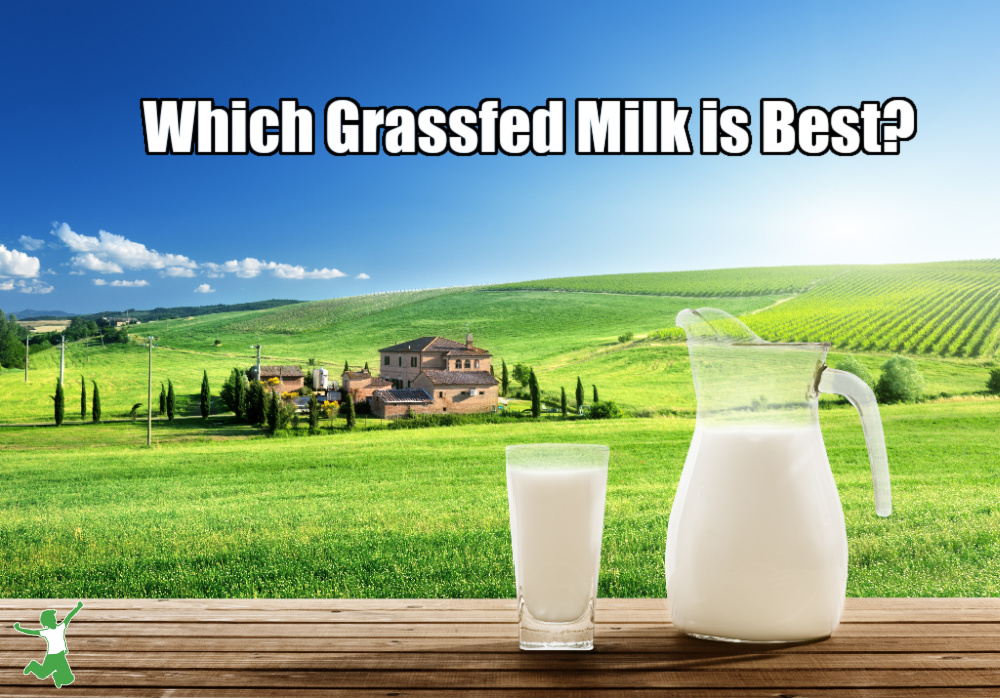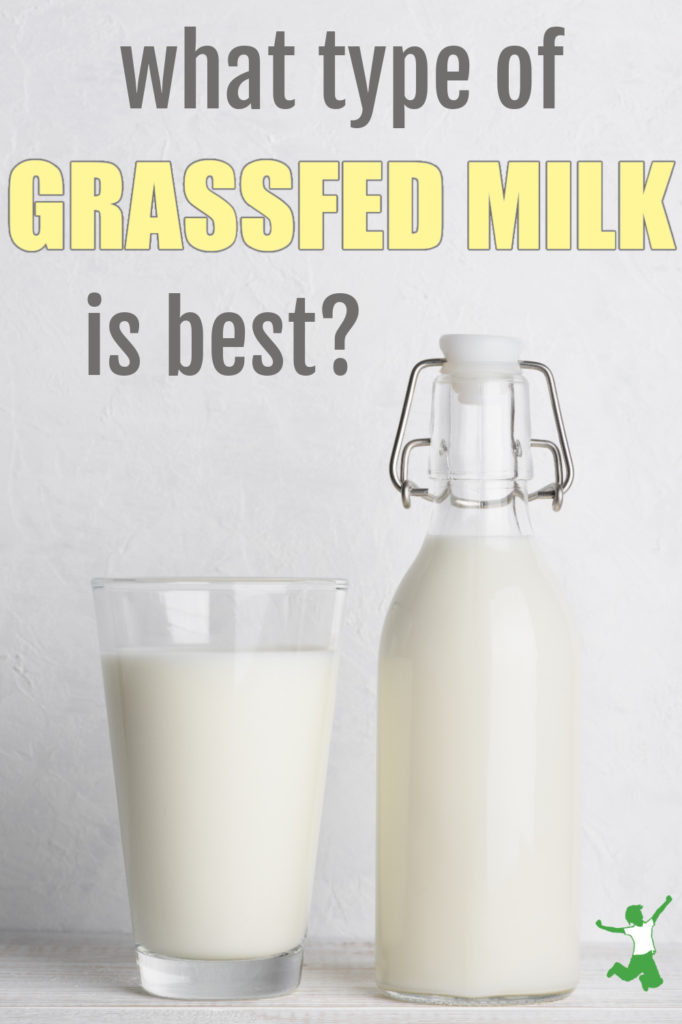Identification of the different types of grassfed milk and how to determine which pastured dairy is best to buy for your family’s health.

When I first began advocating for the benefits of grassfed milk in the diet, especially if unprocessed and fresh from the farm (“raw”), most people were lucky if they could find one such farm in their community producing it.
Fast forward to today nearly 20 years later. Many of us are lucky to have multiple small farms with such products!
While this is a fantastic development especially if you make nourishing baby formula from scratch, it also means that consumer scrutiny of the available choices is necessary.
In other words, each of us is tasked with undergoing an evaluation process to determine which milk is best for ourselves and our families.
What are Common Types of Grassfed Milk?
Recently, I was asked by a friend about the most common types of grassfed milk and which is best. The choices she has in her community are as follows:
- Organically certified, raw, 100% grassfed milk. The pastured milk has very little if any discernable creamline.
- Low temp pasteurized, organically certified grassfed milk that is nonhomogenized (“creamtop”). The cows are fully pastured and the milk is certified A2.
- Organically produced (not certified), raw, grassfed farm where the milk has a large creamline. However, the cows do receive some grain as part of the their primarily pastured diet.
Which type of milk is best to buy for yourself or a growing family?
Let’s analyze each of the choices.
Organic Certified, Raw, 100% Grassfed (low cream)
When raw milk has a tiny to nonexistent creamline, this almost certainly means that the herd consists of mostly holstein cows.
Holsteins produce a lot more milk per cow than other breeds. However, this milk has little to no cream. For this reason, this type of cow is favored by Big Dairy confinement operations because they are a more profitable animal.
When it comes to raw milk, it is my opinion that holsteins are not the best type of cow because the cream is essential for keeping the raw milk fresh.
The cream at the top locks in the freshness.
Not to mention that milk with lots of cream is healthier and has a far more beneficial nutritional profile.
For example, natural Vitamin A and D are located in the cream!
Back in the days before widespread homogenization, consumers identified the quality of the milk based on the thickness of the cream on top.
Eliminating a creamline with homogenization allowed Big Dairy companies to use holsteins to maximize milk output without consumers knowing. It proved a shrewd move, as it also maximized corporate profits.
The raw holstein milk I’ve purchased in the past tended to stay fresh for drinking for only a few days to a week.
Raw milk with a large creamline maintains freshness for much longer. In some cases, it will be fresh for a full two weeks or more during summer when the grass is milder tasting.
Hence, in my view, raw milk from holstein cows, even if 100% organic and grassfed, is not my ideal scenario. Look for grassfed milk from old-fashioned breeds like jersey, guernsey, and devon.
If all you can find is grassfed holstein milk, however, that is fine. It is certainly a huge step up from processed milk at the supermarket.
Organic & A2 Certified, 100% Grassfed, Low Temp Pasteurized (high cream)
What about grassfed milk that is fully pastured and A2 certified but low temp pasteurized and nonhomogenized?
According to microphotography analysis, low temp or “vat pasteurized” milk is damaged structurally compared to raw milk.
Thus, it does not really matter that the milk is organic, fully pastured and A2 certified.
The structural damage to the proteins in the milk from the pasteurization, albeit at a lower temperature, still renders the milk unwise to consume on a regular basis.
I personally would not buy this milk for my family even if it was the only option available.
Organic, Raw, Mostly Pastured Milk (high cream)
The last type of grassfed milk my friend had available in her community is from a farm that pastures its old-fashioned jersey cows. The cows do get some grain as part of their diet. But, it is not a large amount as it is only provided during milking.
The milk is also organically produced (but not certified), raw, and has a large creamline.
If this was my choice, I would hands-down buy this milk for my family.
In my view, the large creamline is far more important to the quality of the milk than the fact that the cows get some grain as part of their mostly pastured diet.
In other words, 100% pastured, low cream raw milk is not as healthy as mostly pastured, high cream raw milk.
Some people may disagree with me on this point. However, my opinion is based on raising three children on this type of milk. They are all healthy without dental issues, so I am happy with the results of that choice many years ago that also fit in very well with our food budget.
What types of grassfed milk do you have available in your area? Which did you choose to buy and why? Has hindsight proved to be 20/20 with this decision?
What if Nonorganic Raw Milk is the Only Type Available?
If you find that the raw pastured milk in your area is not organically produced, this article on the healthiest nonorganic milk to buy can give you some pointers on how to assess a grassfed farm and its quality.









I make L-Reuteri ‘yogurt’ at home. It requires UHT milk or heated up whole milk (organic, grass-fed) to 180 degrees. The benefits of L-Reuteri are super, but I just hate using the UHT milk. Raw milk doesn’t work (however, I do make the instant powdered Kefir with it which is ok).
The good bacteria one gets with L-Reuteri outweighs the negative (supposedly) of the UHT milk. What do you think?
Fermenting UHT milk does not outweight the downside of how allergenic it is.
You can make raw milk L. reuteri yogurt using this method. https://www.thehealthyhomeeconomist.com/slow-cooker-yogurt/
I also use option two for my Kefir. If this option is that bad then drinking milk for the vast majority is not going to happen. I live in Ohio and deal with farmers for my grass fed beef, eggs, poultry, and the such, even some raw milk cheese and when you ask them about purchasing the raw milk it is not going to happen. Most people even in these circles think you are on the moon for wanting it plus the fact that it is illegal unless you are part of a cow share program. There are some programsbut they are few and far between.
All the health food stores in my area sell ultra-pasteurized milk. If pasteurized isn’t healthy how could ultra-pasteurized be healthy?
Ultrapasteurized is not healthy … this should never be consumed. https://www.thehealthyhomeeconomist.com/organic-milk-healthfood-trojan-horse/
Great article! I live in Maryland and I have not been able to track down raw milk anywhere. Obviously, I know raw milk is the BEST but since I can’t find any in my area I found the next best thing (so I thought ??). There is a local farm that is literally exactly like one of the options you have above- low temp pasteurized, grass fed with grain only for milking, all A2 Jersey cows, organic practices…
I have 4 children 5 and under and we drive to the farm 1 x per month and stock up and freeze the milk . My goodness it is so expensive – $6.50 per gallon. That is crazy expensive for our budget…. Now I’m wondering is this is worth it compared to something I could get at the grocery store. I do use it make kefir as well.
Would LOVE to hear your opinion… am I throwing my money away? What would you do ? You said in the article you would not use this milk if it was the only option available…. Grocery store milk? Gosh, my dream of homesteading and milking my own cow couldn’t be more impossible. But Hallelujah, I serve a God where nothing is impossible!
I should add that I thought the low temp pasteurization was better then burning absolutely everything up… maybe some digestible nutrients left? We actually noticed a quick change in my husband’s reaction to dairy with this… he always gets immediate gas when he has ice cream or typical junk Walmart milk that we used to buy before we were AWAKENED (Thank God). So when I started researching milk options for my first child when she was weaned I thought the local farms milk was going to be the most nutritious option for her/us. And it must be better than typical pasteurization because my husband does not get gas with the farms milk like he does when he consumes other dairy elsewhere. ?♀️
Low temp pasteurization is not much better than regular. Everything is destroyed enzyme and probiotic-wise (that is the definition of pasteurization). About half the Vitamin C is lost among other nutrient reductions. That said, low temp pasteurized milk is not usually homogenized, which destroys the fat globules in addition to rendering the proteins allergenic (this is pasteurizing does) … perhaps that is why your husband is better on it… the fat is easier to digest slightly? I personally would not drink milk at all if I could not get it unprocessed.